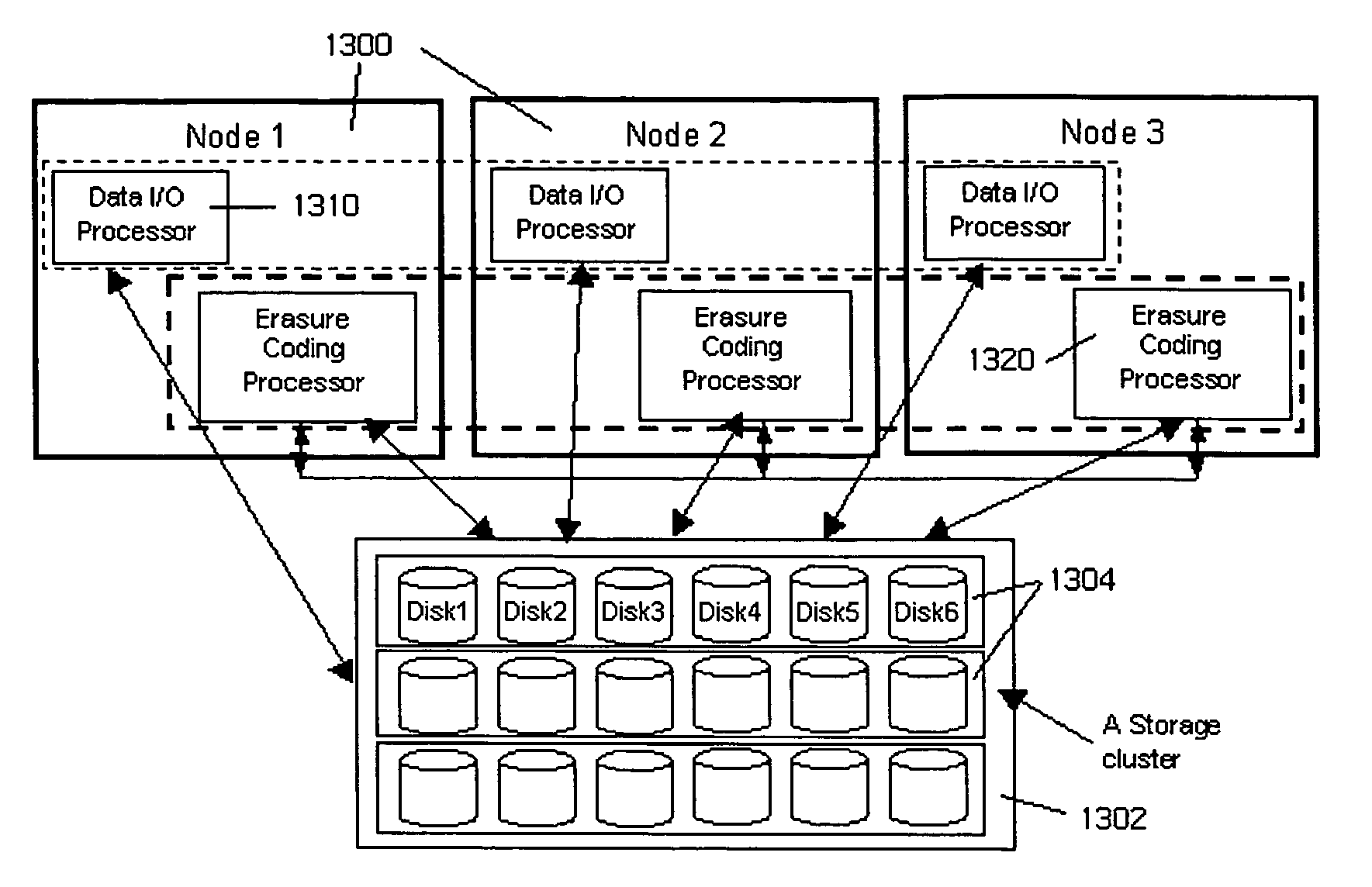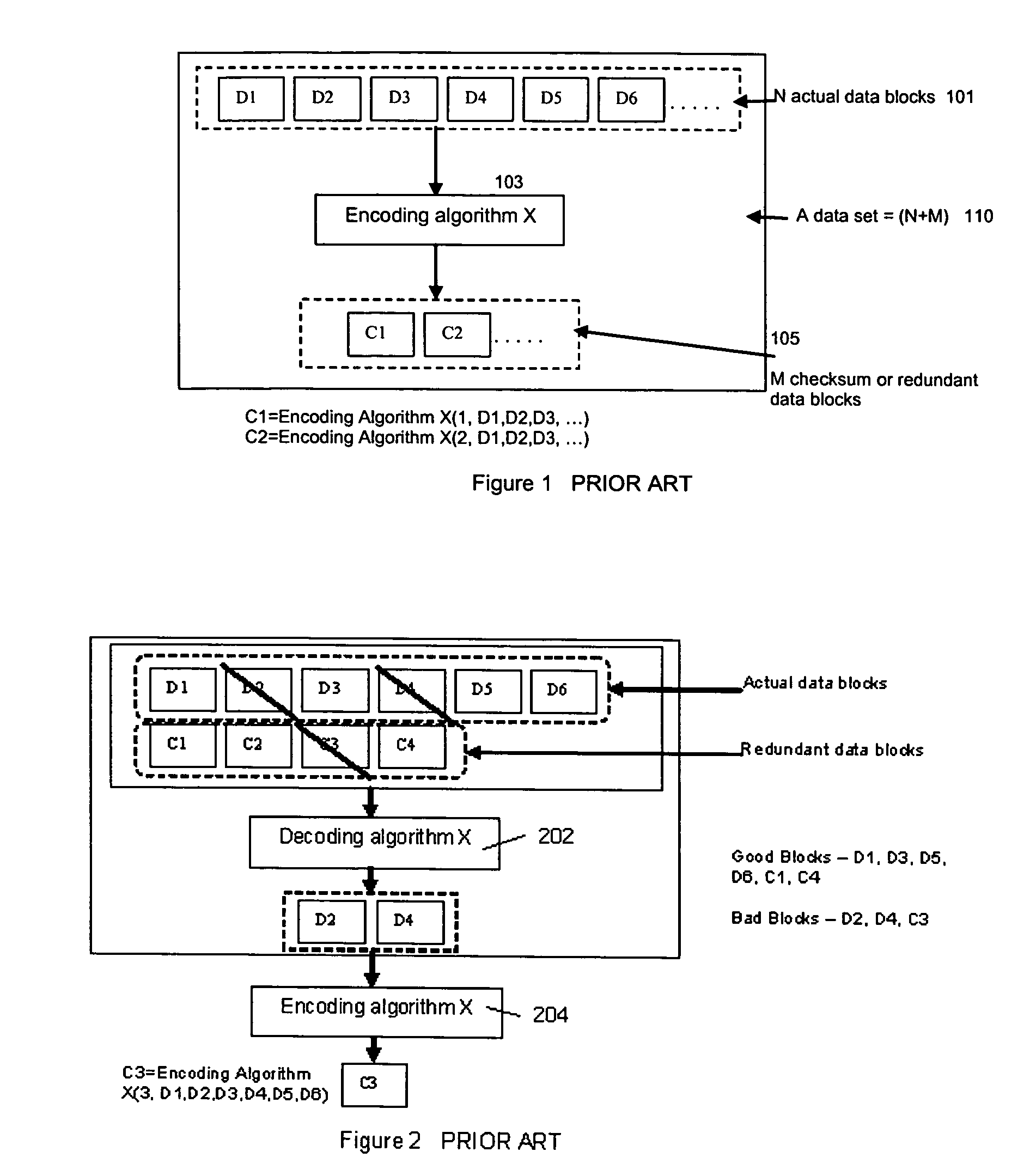Method for lock-free clustered erasure coding and recovery of data across a plurality of data stores in a network
a data store and clustering technology, applied in the field of lock-free clustered erasure coding and data recovery, can solve the problems of multiple failures of dimensional parity coding, inconsistent and incorrect set of data blocks, and the decoding process generating incorrect data, so as to and maintain data consistency and correctness.
- Summary
- Abstract
- Description
- Claims
- Application Information
AI Technical Summary
Benefits of technology
Problems solved by technology
Method used
Image
Examples
case 1
Failure
[0092]At time t5, assume that data block D4 changed, C1 is updated, but that C2 fails to be updated due to some device failure. The registry values are then as follows:
Time t5: D4 changed
Counter C=5
[0093]
D1D2D3D4D5C1C20145354
[0094]In such case, there are now two data set partitions:[0095]Data set partition 1=(D1, D2, D3, D4, D5, C1) state of t5 [0096]Data set partition 2=(D1, D2, D3, D5, C2) state of t4
[0097]In this data set configuration, five (5) blocks (any of the actual data and checksum blocks) are required to reconstruct the entire seven (7) element data set. To bring the entire seven element set to a consistent state, either partition 1 or partition 2 can be used.
[0098]Assume that C2 becomes accessible later and no data is corrupted. The method either can roll forward the entire data set to state of t5 by using partition one (1), or it can roll backward the data set to the state t4 by using partition two (2).
case 2
Failure
[0099]At time t5, assume D4 changed, C1 is updated, but that C2 fails to be updated due to the C2 device failure and the device is to be replaced. The registry values are then as follows:
Time t5: D4 changed
Counter C=5
[0100]
D1D2D3D4D5C1C2014535*
[0101]In this case, there are now two consistent data set partitions:[0102]Data set partition 1=(D1, D2, D3, D4, D5, C1) state of t5[0103]Data set partition 2=(D1, D2, D3, D5) state of t4
[0104]Because in this example a minimum of five (5) elements is required to recover the entire data set (due to the encoding scheme used), partition 2 is unacceptable. Thus, the only recovery choice is to roll forward to t5 using partition one (1). The checksum block C2 in this case cannot be recovered, e.g., until a replacement device is ready. During this time, the data set can continue to be modified and updated as long as there is a consistency management method to identify the consistency and recover the data at any time in the future.
case 3
Failure
[0105]At time t5, assume D4 changed, and both C1 and C2 devices fail and replaced. The registry values are now as follows:
Time t5: D4 changed
Counter C=5
[0106]
D1D2D3D4D5C1C201453**
[0107]In this case, there is only one consistent data set partition:[0108]Set 1=(D1, D2, D3, D4, D5) state of t5
[0109]When replacement data stores are inserted, C1 and C2 can be reconstructed to state of t5.
[0110]Although in the above examples the encoding method uses an increment of one (1) for the sequence number, this is not a requirement or a limitation of the technique. For example, the counter can be increment by a given amount, e.g., −1, 2, or any number. Moreover, the sequence number itself can be a given function of the counter.
[0111]Generalizing, as can be seen, the above-identified sequencing scheme involves several basic steps: (a) initializing a counter; (b) storing sequence numbers in a data structure (such as the registry table illustrated above) having N+M positions corresponding to t...
PUM
 Login to View More
Login to View More Abstract
Description
Claims
Application Information
 Login to View More
Login to View More - R&D
- Intellectual Property
- Life Sciences
- Materials
- Tech Scout
- Unparalleled Data Quality
- Higher Quality Content
- 60% Fewer Hallucinations
Browse by: Latest US Patents, China's latest patents, Technical Efficacy Thesaurus, Application Domain, Technology Topic, Popular Technical Reports.
© 2025 PatSnap. All rights reserved.Legal|Privacy policy|Modern Slavery Act Transparency Statement|Sitemap|About US| Contact US: help@patsnap.com



